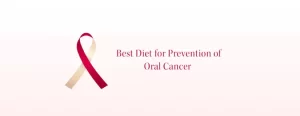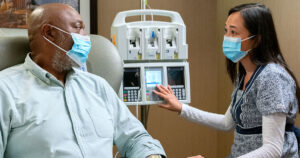It was early in 2021 and Onjalai Brown was looking forward to the rest of her life. She was in her 30s, had a job she enjoyed and was living as a newlywed in Dallas.
She was had no idea a storm was brewing.
It wasn’t long after her wedding that Brown and her husband began having marital issues. A few months later, she suffered a devastating miscarriage.
Then, she found a lump in her breast.
That September, Brown was diagnosed with breast cancer—specifically, stage 2 invasive ductal carcinoma, the most common type of breast cancer, comprising 80 percent of all diagnoses, according to the American Cancer Society. The cancer starts in the cells that line the breast’s milk ducts, then spreads into surrounding tissues.
Once Brown received the diagnosis, her marriage collapsed and her husband left. Nervous to navigate the disease alone but still determined, Brown sought a referral from her primary care doctor and ended up at the same oncology group that had treated her sister, who’d passed away from breast cancer years earlier.
“I had PTSD,” Brown says. “I didn’t want to go through that same process. It wasn’t that she didn’t have good care. There were just things that I wanted to be different for myself as the patient.”
Someone suggested Brown try City of Hope Phoenix, where she learned the value of getting a second opinion.
“I went for a consultation and fell in love with it,” Brown says. “It’s a night-and-day difference compared to other medical institutions—from the pickup at the airport by the transportation team to the initial consultation with the physician.”
Although it would mean traveling back and forth from Dallas to Phoenix and eventually resigning from her job, which required her to work onsite, Brown knew where she wanted to be treated.
Still, as much as Brown had already been through, her journey was far from over.
In this article, we’ll explore Brown’s treatments and accompanying side effects, as well as her advice for other breast cancer patients and her outlook on life, post-treatment. Topics include:
- Managing the worst days after chemotherapy treatment
- Navigating radiation therapy side effects
- Advice for other breast cancer patients
- Life after invasive ductal carcinoma treatment
If you’ve been diagnosed with breast cancer and are interested in a second opinion on your diagnosis and treatment plan, call us or chat online with a member of our team.
Cancer Fighters
Created by City of Hope patients in 1990, the Cancer Fighters® community offers patients and their families the opportunity to tap into the experiences of members across the country.
LEARN MORE AT CANCERFIGHTERS.COM

Managing the worst days after chemotherapy
Without a job and with her personal life in tatters, Brown soon found herself without a permanent address. “I was going from one person’s house to another and staying in a hotel sometimes,” she says. “My top priorities were just shelter and security.”
When a genetic test revealed was positive for the BRCA gene mutation, Brown had a decision to make about treatment. She could either choose a double mastectomy (surgery to remove both breasts) or a lumpectomy (surgery to remove cancerous tissue from the breast).
“I chose to do a lumpectomy because of the state of my life at the time,” Brown says, “and with the knowledge that I could choose to do a double mastectomy at a later date.”
The surgery took place in December 2021. Because she’d chosen a lumpectomy versus a double mastectomy, Brown’s care team recommended chemotherapy and radiation therapy as an additional level of protection.
Facing red devil chemo side effects
In total, Brown underwent 20 rounds of chemotherapy with significant side effects. She experienced nausea, bone pain and extreme fatigue due to the chemotherapy, especially after four rounds of doxorubicin, a chemotherapy drug nicknamed “Red Devil” for its bright red color and very difficult side effects.
She also suffered from hair loss and neuropathy, as well as discoloration in her fingernails and toenails. In addition, Brown developed several infections that landed her in the emergency room.
“The infections weren’t anything more than a typical cold or gastrointestinal virus, but because I was immunocompromised and already weak, they were amped up to another level,” she recalls.
The worst side effect, however, was depression, which was compounded by everything else going on in her life. At one point, the load became so heavy, in fact, that she contemplated suicide.
“My marriage had just ended, which I thought was the beginning of the rest of my life,” Brown says. “I’d lost a child. I’d lost a job that I loved at the time. I had 12 family members with BRCA-linked cancers, some of whom hadn’t lived to share their story. I didn’t know if I had any hope of moving forward in the future. I was lonely, and it was hard to find hope.”
Navigating radiation therapy side effects
During her treatment, Brown also underwent 33 rounds of radiation therapy, which caused side effects like:
- Breast and chest pain
- Pain and swelling under the arm
- Extreme fatigue
- Nausea
- Burning and open wounds
Brown worked with her care team to address these side effects, taking pain and anti-nausea medicines, applying topical ointments to help reduce infection and promote healing, using ice compresses to reduce swelling, and getting plenty of rest.
Although Brown was going through the motions of treatment and side effect management, the turning point for her came during one hospital visit when a nurse took her aside.
“She said, ‘Girl, you got it,’” Brown recalls. “‘I don’t know what it is, but there’s just something about you, and I know this isn’t going to take you down. Once you get to the other side, I just know you’re going to shout it from the rafters and let everyone who hears your voice be encouraged by what you’ve been through.’
“Something clicked that day,” Brown says. “I made the decision that not only was I going to beat this, but I was going to use it to encourage other people in similar circumstances.”
Brown moved to Phoenix in the summer of 2022 and got involved with her church and also sought at spiritual support services offered at the hospital. She also made friends in the community and found the strength to complete a master’s degree in business administration. Brown finished her degree in September, in fact—the same month she completed breast cancer treatment and one year after her initial diagnosis.
“It was the thing that anchored me,” Brown says. “It was something to keep pushing toward, and it ended up being a pretty cool culmination of one of the roughest seasons of my life.”
Advice for other breast cancer patients
Today, Brown is 37 and using her experience to educate and motivate others to seek medical attention if they notice something that doesn’t feel right to them, like a lump in the breast.
“I believe knowledge is power, and early detection is key,” she says. “The sooner you know, the more options you have.”
Brown also encourages people to get a second opinion, a decision she made shortly after her diagnosis.
“If you’re at the diagnosis stage and don’t feel your needs are being met, don’t hesitate to get a second, third or even fourth opinion,” she says. “You need to feel empowered as the patient to get the care you need and deserve.”
To cancer patients in the middle of treatment, Brown advises looking for a reason to smile, even on the darkest days. “Just cling to hope,” she says. “There’s hope everywhere if you look for it.”
Life after invasive ductal carcinoma treatment
For Brown, life after breast cancer treatment has also meant a new job, as business development and event programmer for the National Diversity Council’s chapters in Arizona and Colorado. She views the role as a way to help everyone have a voice.
“I know people can be marginalized because of their background, belief system or sexual orientation, particularly in the realm of health care,” she says. “I want to help remind people that if they have breath, they have value and they have power.”
She also wants to remind people that what they do today can inspire people tomorrow.
“You know that all things work for good,” Brown says. “You know it, but sometimes it’s really hard to grasp it in the middle of the storm. I’m so blessed and grateful today to look back at that past version of myself. I’m proud of her. I’m proud of her for choosing to push through. And I know that everything I went through will help the person coming behind me.”
If you’ve been diagnosed with cancer and are interested in a second opinion on your diagnosis and treatment plan, call us or chat online with a member of our team.



